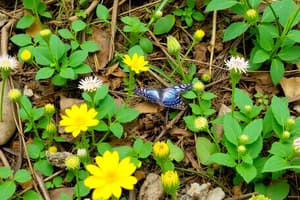Podcast
Questions and Answers
What defines species richness in an ecological community?
What defines species richness in an ecological community?
- The variety of different habitats present in the community
- The abundance of individual species present
- The number of different species present in the community (correct)
- The overall biomass of all species combined
Which factor is NOT included in the measure of species diversity?
Which factor is NOT included in the measure of species diversity?
- Competition between species (correct)
- Relative abundance
- Variability of species
- Species richness
How does community B differ from community A in terms of abundance?
How does community B differ from community A in terms of abundance?
- It has more species overall.
- It lacks certain species found in community A.
- It has higher overall species richness.
- It has unequal distribution among species. (correct)
In community A, what is the species diversity if all 10 species have equal abundance?
In community A, what is the species diversity if all 10 species have equal abundance?
Which concept explains how different species can coexist in the same community?
Which concept explains how different species can coexist in the same community?
What is a likely outcome if two species occupy the same niche?
What is a likely outcome if two species occupy the same niche?
Why do three different butterfly species in the same garden rarely compete with each other?
Why do three different butterfly species in the same garden rarely compete with each other?
In the scenario with a shelf fungus and a slug on a decaying tree trunk, how do these organisms interact?
In the scenario with a shelf fungus and a slug on a decaying tree trunk, how do these organisms interact?
Which of the following statements best describes a consequence of competition for resources?
Which of the following statements best describes a consequence of competition for resources?
Is it true that only two species can occupy the same habitat?
Is it true that only two species can occupy the same habitat?
What behavior allows individuals to live in groups to increase their chances of survival?
What behavior allows individuals to live in groups to increase their chances of survival?
What is the main purpose of warning coloration in animals?
What is the main purpose of warning coloration in animals?
Which process involves a series of species replacements over time within a community?
Which process involves a series of species replacements over time within a community?
In which type of succession does colonization occur in an area previously devoid of life?
In which type of succession does colonization occur in an area previously devoid of life?
What are pioneer species known for in the context of ecological succession?
What are pioneer species known for in the context of ecological succession?
What type of interaction occurs when both species involved are harmed?
What type of interaction occurs when both species involved are harmed?
What is a common result of secondary succession?
What is a common result of secondary succession?
Which of the following characteristics is NOT associated with protective adaptations in animals?
Which of the following characteristics is NOT associated with protective adaptations in animals?
In which type of interaction does one species benefit while the other is not affected?
In which type of interaction does one species benefit while the other is not affected?
What do poisonous chemicals in prey typically aim to achieve?
What do poisonous chemicals in prey typically aim to achieve?
Which defense mechanism helps prey avoid predators by blending into their surroundings?
Which defense mechanism helps prey avoid predators by blending into their surroundings?
What is the relationship between a lion and a warthog when the lion hunts the warthog?
What is the relationship between a lion and a warthog when the lion hunts the warthog?
How does a tick interact with a dog in terms of species interaction?
How does a tick interact with a dog in terms of species interaction?
Which of the following describes a scenario of mutualism?
Which of the following describes a scenario of mutualism?
What is one of the adaptations that can serve as a defense mechanism for prey against predators?
What is one of the adaptations that can serve as a defense mechanism for prey against predators?
What happens to prey populations in the presence of predators?
What happens to prey populations in the presence of predators?
What type of interaction occurs when both species benefit from their relationship?
What type of interaction occurs when both species benefit from their relationship?
Which of the following examples represents commensalism?
Which of the following examples represents commensalism?
In which type of interaction is the host organism harmed?
In which type of interaction is the host organism harmed?
What is a characteristic of ectoparasites?
What is a characteristic of ectoparasites?
What accurately describes intraspecific interactions?
What accurately describes intraspecific interactions?
Which interaction type involves competition for resources?
Which interaction type involves competition for resources?
Which scenario illustrates mutualism?
Which scenario illustrates mutualism?
What is the primary focus of community ecology discussed?
What is the primary focus of community ecology discussed?
Flashcards are hidden until you start studying
Study Notes
Community Ecology Overview
- A community consists of all populations living in a specific area and their interactions.
- Community structure can be assessed through species richness and species diversity.
Species Richness
- Defined as the number of different species in a community.
- Does not account for the abundance of each species.
Species Diversity
- Measures diversity within a community, incorporating both species richness and relative abundance.
- Example comparison: Community with equal abundance of 4 species shows higher diversity than one with 80% of one species.
Competitive Exclusion Principle
- When two species occupy the same niche, they will compete.
- Outcomes include one species outcompeting the other or one species potentially going extinct.
Resource Partitioning
- Species can reduce competition by utilizing different resources or habitats.
- Example: Different butterfly species in the same garden avoid competition by occupying different niches.
Types of Interactions
- Intraspecific Interactions: Relationships among individuals of the same species.
- Interspecific Interactions: Relationships among individuals of different species, the focus of community ecology.
Symbiotic Relationships
- Mutualism (+/+): Both species benefit (e.g., cattle egret and rhino; butterfly and flower).
- Commensalism (+/0): One species benefits, the other is unaffected (e.g., clownfish in anemone; cattle egrets with grazing cattle).
- Parasitism (+/-): One species benefits at the expense of the other (e.g., ticks or mosquitoes feeding on hosts).
Competition
- Can be intraspecific (within the same species) or interspecific (between different species).
- Both competitors are harmed by the interaction (-/-), competing for resources like food and mates.
Predation
- An interaction where a predator hunts and feeds on prey.
- Benefits the predator while harming or killing the prey (+/-).
Prey Defense Mechanisms
- Various adaptations help prey avoid predators:
- Camouflage: Blending with surroundings.
- Flocking Behavior: Living in groups for increased survival.
- Protective Spines/Thorns: Injurious defenses against predators.
- Warning Coloration: Bright colors to signal danger.
- Mimicry: Harmless species resemble harmful ones.
- Poisonous Chemicals: Defenses that induce sickness in predators.
- Speed: Ability to outrun predators.
Ecological Succession
- A process of species replacement in a community over time after disturbances.
- Primary Succession: Occurs in previously uninhabited areas (e.g., rock surfaces post-volcanic activity).
- Secondary Succession: Follows disturbances in areas with existing communities, more common (e.g., after fires or logging).
Pioneer Species
- First species to colonize post-disturbance.
- Essential for initializing ecological succession and increasing biodiversity in affected areas.
- Typically consist of plants, followed by animals that feed on them.
Studying That Suits You
Use AI to generate personalized quizzes and flashcards to suit your learning preferences.




